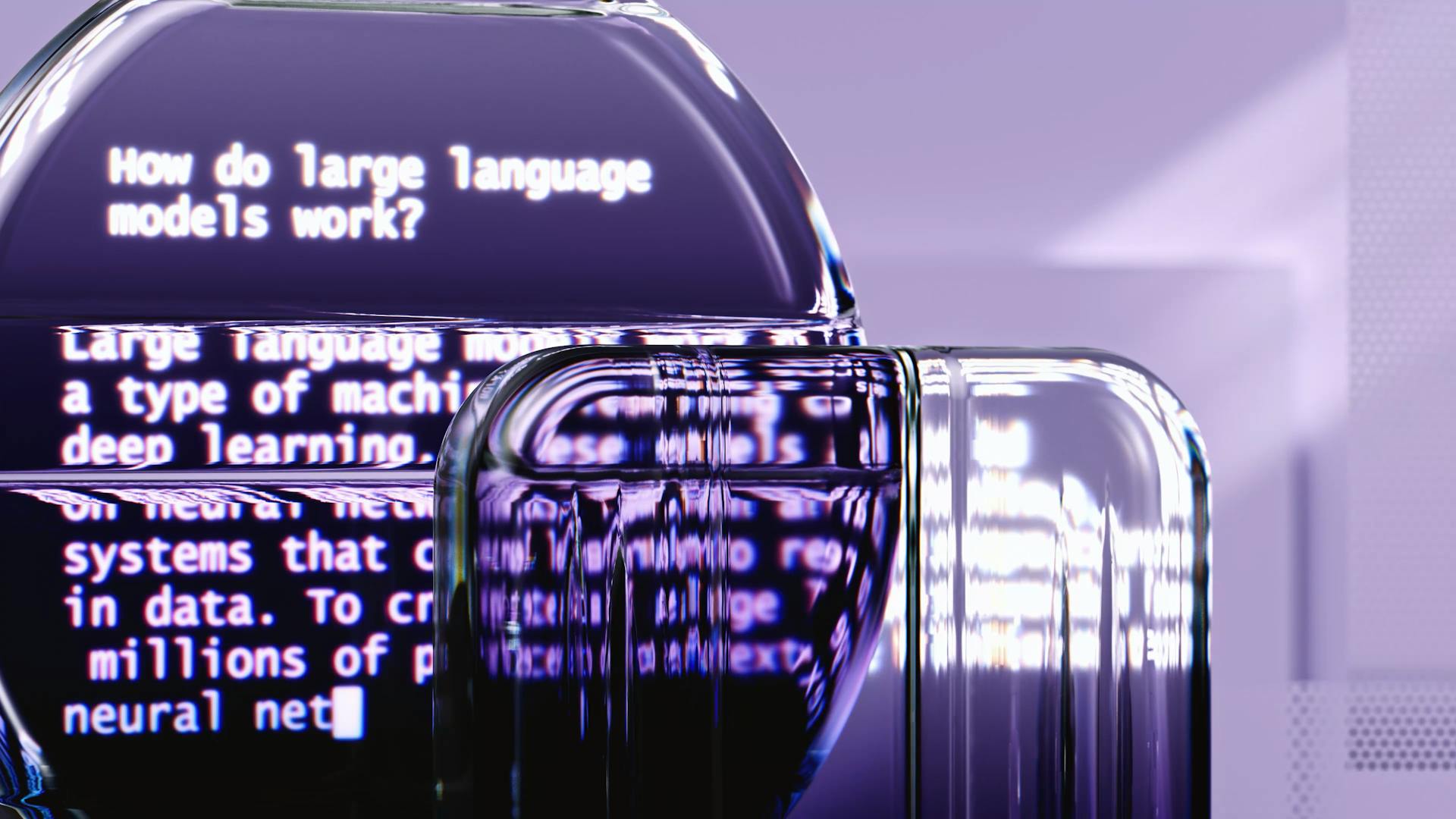
Finetuning a Lora model can be a game-changer, but it requires the right approach. One key strategy is to use a smaller learning rate for the last few epochs, as shown in the "Lora Finetune" article, where a learning rate of 0.01 was used for the last 5 epochs.
This helps prevent overfitting and ensures the model converges smoothly. By doing so, you can achieve better performance without sacrificing model stability.
Another effective technique is to use a combination of warmup and cosine annealing, as demonstrated in the article where a warmup period of 5% of the total training steps was used, followed by cosine annealing for the remaining 95% of the steps.
This approach helps the model adapt to the new task while maintaining a stable learning rate, leading to improved results.
Curious to learn more? Check out: Fine Tune Llama 2 with Lora
Preparing for Fine-Tuning
To fine-tune a language model, you'll first need to create and prepare a dataset. A good dataset should have a diverse set of demonstrations of the task you want to solve.
The HuggingFaceH4/no_robots dataset is a high-quality dataset of 10,000 instructions and demonstrations created by skilled human annotators. It's comprised mostly of single-turn instructions.
This dataset has 10,000 examples, split into 9,500 training and 500 test examples. Some samples are missing a system message.
You'll need to load the dataset with the datasets library, add a missing system message, and save them to separate json files.
Fine-Tuning Techniques
Fine-tuning techniques can make a big difference in how well your model performs. Targeting attention blocks is a common approach, but research suggests that targeting all linear layers can result in superior adaptation quality.
The rank of update matrices, denoted by 'r', plays a crucial role in fine-tuning. A lower 'r' value can expedite the training process, but may come at the cost of model quality. Increasing 'r' beyond a certain point may not yield noticeable improvement in model performance.
Here are some key parameters to consider when fine-tuning with LoRA:
- target_modules: The modules to apply the LoRA update matrices.
- r: Rank of update matrices, lower rank results in smaller update matrices with less trainable parameters.
Merge Adapter into Original Model
Merging the adapter into the original model is a useful technique when fine-tuning. This process makes it easier to use the model with Text Generation Inference.
You can merge the adapter weights into the model weights using the merge_and_unload method. This method is specifically designed for this purpose.
By merging the adapter into the original model, you can save the full model, which includes both the adapter and model weights. This is a more convenient option for inference tasks.
The merged model can be saved using the save_pretrained method. This will create a default model that can be used for inference.
Saving the full model with the adapter merged in makes it easier to use with Text Generation Inference. This is a big advantage for those who need to use the model for generating text.
If this caught your attention, see: Llama 3 8b Best Finetune Model
Fine-Tuning LLM with FSDP and SDPA
FSDP (Fully Sharded Data Parallelism) is a technique that can be used in conjunction with finetuning to improve model performance. It's a method that's particularly useful for large language models.
Finetuning with FSDP involves loading adapters to the base model using the .load_adapter method. This allows you to attach LoRA (ΔW) weights to the base model. The adapters can be loaded from a specific path and given a unique name.
The LoRA weights can be updated using the LoRA tuning mechanism, which creates two smaller weight update matrices. These matrices are then used to update the weights of the neural network during backpropagation and forward pass.
Here are some key parameters to consider when fine-tuning with LoRA:
- r: the rank of the low-rank matrices, which can affect the number of parameters that require updating
- target_modules: the modules to apply the LoRA update matrices to, such as attention blocks or linear layers
- LoRA dropout and alpha values can also be adjusted to fine-tune the model
By fine-tuning with FSDP and SDPA (Sparse Data Parallelism), you can achieve significant improvements in model performance and reduce the computational resources required.
Hot Swapping
Hot Swapping is a technique that can help you scale fine-tuning more efficiently.
You don't expect equal traffic from all 1000 of your customers, so holding in memory the 100 most frequently queried customers can be a good strategy.
Building an LRU cache and hot swapping models with new requests coming in can help reduce costs.
For a single instance of A100-40Gb, the cost is less than $3k per month.
You can hold a lot more models in memory with QLoRA due to quantization, making it even more cost-efficient.
Scaling infrastructure for customers with higher traffic is easier with hot swapping, and it also scales better with the number of customers and tasks.
Loading and unloading models can take a small hit on latency.
Hot swapping is the most cost-efficient and practical way of scaling fine-tuning, according to the approach we'll be sharing in the rest of this blog.
Understanding Peft
PEFT is a library from Hugging Face that helps train models efficiently, one of its options being LoRA.
PEFT stands for Parameter-Efficient Fine-Tuning, a library that allows you to adapt pre-trained language models to various downstream applications without fine-tuning all the model's parameters.
PEFT methods only fine-tune a small number of extra model parameters, significantly decreasing computational and storage costs because fine-tuning large-scale pre-trained language models is prohibitively costly.
Recent state-of-the-art PEFT techniques achieve performance comparable to that of full fine-tuning, making it a valuable tool for efficient model adaptation.
Suggestion: Pre Trained vs Fine Tune
What Is Peft?
PEFT is a library from Hugging Face that helps train models efficiently, one of its options being LoRA. It's a game-changer for adapting pre-trained language models to various downstream applications.
PEFT stands for Parameter-Efficient Fine-Tuning, a library for adapting pre-trained language models to various downstream applications without fine-tuning all the model's parameters. This approach significantly decreases computational and storage costs.
By fine-tuning a small number of extra model parameters, PEFT methods achieve performance comparable to that of full fine-tuning. This is a major breakthrough in the field of natural language processing.
PEFT Finetuning is a set of fine-tuning techniques that allows you to fine-tune and train models much more efficiently than normal training. This is achieved by reducing the number of trainable parameters in a neural network.
The most famous and in-use PEFT techniques are Prefix Tuning, P-tuning, LoRA, etc. LoRA is perhaps the most used one, and it has many variants like QLoRA and LongLoRA, which have their own applications.
Broaden your view: Ai Lora Training
What Is
LoRA is an adapter-based approach that proposes storing changes in a separate matrix, ΔW, and freezing the original weight matrix (W) of the base model.
This allows for seamless task switching during inference by attaching or detaching the adaptable lens-like ΔW from the base model as needed.
LoRA reduces memory footprint by using a low-rank approximation, decomposing ΔW to Wa x Wb with a specified matrix rank.
Quantized LoRA (QLoRA) takes it a step further by loading the pre-trained model into GPU memory with quantized 4-bit weights, known as NF4.
LoRA can be thought of as detachable layers that seamlessly integrate with a base model, keeping the model size the same.
New parameters are added only for the training step, not as a part of the model, offering flexibility in parameter-efficient finetuning.
LoRA breaks down the weight update matrix into smaller matrices, A and B, with r as their rank, to train the model using normal backpropagation.
These smaller matrices can be multiplied together to get back the original matrix, using fewer parameters and computation resources.
By learning the ΔW through smaller matrices, LoRA results in smaller checkpoints, as you don't have to store the whole model, just the smaller matrices.
Here's an interesting read: Fine Tune Embedding Models
Approach 3: Llama 2-7B
Approach 3: Llama 2-7B is an alternative method that can produce similar quality results as Approach #1, but with a significant cost savings. This approach involves fine-tuning 500 variants of Llama 2-7B, which requires about 3 instances of A100-40GB GPUs, costing around $8k.
Each delta weight in this approach consumes about 200MB of memory, which is a relatively efficient use of resources. This is a key advantage of Approach 3, as it allows for more variants to be processed without breaking the bank.
To achieve this, you'll need a total of fine-tune large language models without sacrificing quality.
For another approach, see: Fine Tune Llama 2 Huggingface
What Is the Difference Between Adapters and Connectors?
Adapters and LoRA are two popular techniques used in transfer learning, but they have some key differences. Adapters add extra layers to the original model, increasing its depth and causing additional latency during inference.

This increased complexity comes with a significant training effort, requiring updates to the same number of parameters as the pre-trained model. In fact, training a massive model for each task is not feasible due to computing and memory requirements.
To tackle these challenges, researchers introduced LoRA, which reduces the learnable parameters in newly initialized layers. LoRA uses smaller matrices to approximate the large parameter matrices, significantly reducing the number of trainable parameters.
For example, if we have a W matrix with 6.25 million parameters, selecting an r of 8 can reduce the number of trainable parameters to 40,000 – a reduction of approximately 156 times.
Here's a comparison of Adapters and LoRA:
As we can see, LoRA offers a more efficient solution by reducing the number of trainable parameters, making it a more feasible option for training large models.
How Q Differs
Understanding Peft requires a solid grasp of its components, including QLoRA and LoRA. QLoRA is a finetuning technique that uses LoRA as an accessory to fix errors introduced during quantization.
You might like: Architecture for Users to Fine Tune Lora
QLoRA is specifically designed to address the limitations of LoRA, which is more of a standalone finetuning technique. LoRA is not equipped to handle quantization errors on its own.
In comparison, QLoRA's reliance on LoRA makes it a more robust and effective finetuning method. This combination is what sets QLoRA apart from LoRA.
You might enjoy: Huggingface Finetuning Ast
Benefits and Advantages
Finetuning with LoRA can save you a significant amount of time. With fewer trainable parameters, you can train models much faster and test them faster too.
The time saved can be used to experiment with different models, datasets, and techniques. This allows for more thorough exploration and optimization of your models.
LoRA also enables 4-bit quantization, leading to memory reduction and making large language models more accessible.
Optimization and Performance
LoRA finetuning is a powerful technique that can significantly improve model performance, reducing inference time by up to 70% after applying DeepSpeed optimization.
DeepSpeed optimization can slash inference times dramatically, as seen in a 70% reduction from 2800ms to just 800ms.
You might like: Hyperparameter Optimization
This means you can handle extensive workloads with ease, making it an ideal choice for production scenarios.
However, it's worth noting that the support for multiple LoRA adapters on HuggingFace Text Generation Inference is still under development.
The model's inference time can be further optimized using DeepSpeed, although delving into this is beyond the scope of this article.
To streamline the pipeline for swifter inference, you can merge the adapter weights with the base model, making it a feasible approach to conduct inference with LoRA weights.
A code snippet for this process is provided, showing how to load the finetuned adapter weight onto the base model and merge the adapter weights to the base model.
The merge_and_unload() method is used to merge the adapter weights with the base model, which is then optimized using DeepSpeed.
For your interest: Huggingface Transformers Model Loading Slow
Exploring Variants and Techniques
You can attach LoRA weights using the `.load_adapter(model_path, adapter_name)` method. This method is useful for fine-tuning a model with LoRA.
The LoRA rank, denoted by `r`, plays a crucial role in determining the number of parameters that require updating in the low-rank adaptation. A lower `r` value can expedite the training process, but this might come at the cost of model quality.
By targeting specific modules within the model's architecture, you can tailor the adaptation process to focus on areas that need improvement. Traditionally, practitioners tend to target only the attention blocks of the transformer, but recent research suggests that targeting all linear layers can result in superior adaptation quality.
Here are some key parameters to consider when fine-tuning with LoRA:
- target_modules: The modules (for example, attention blocks) to apply the LoRA update matrices.
- r: rank of update matrices, lower rank results in smaller update matrices with less trainable parameters.
Note that increasing `r` beyond a certain point may not yield any noticeable improvement in the model's performance.
Qlo vs Standard
In QLoRA, the number of LoRA adapters required is higher compared to standard LoRA finetuning. This means that for QLoRA, you'll need to apply LoRA adapters on all linear transformer blocks, as well as the query, key, and value layers.
The performance of QLoRA is on par with standard LoRA finetuning, even for larger language models. For example, the T5 model family shows no loss of performance when trained with QLoRA.
Double Quantization also doesn't seem to make a significant difference in performance. The authors of the paper even trained a model on top of a 33 billion parameter base LLaMA model, Guanaco, with great results.
This large model, Guanaco, achieved 99.3% performance relative to ChatGPT, and it used 4-bit precision, which resulted in less memory usage compared to a 13 billion parameter model.
Other Variants
The use of various techniques and tools can help improve the effectiveness of your approach.
Some variants include the "sandwich" method, which involves placing a positive statement between two negative statements to soften the criticism.
This can be a useful approach when giving feedback to someone who is sensitive to criticism.
The "broken record" technique, on the other hand, involves repeating a key message or phrase to drive home a point.
This can be particularly effective in situations where you need to convey a clear and concise message to someone who may be resistant to change.
The "gray rock" method involves remaining neutral and unemotional, like a gray rock, to de-escalate conflicts.
This can be a helpful approach when dealing with someone who is angry or aggressive.
It's worth noting that the effectiveness of these variants can depend on the specific situation and the people involved.
Frequently Asked Questions
What is LoRA in fine-tuning?
LoRA (Low-Rank Adaptation) is a fine-tuning method that uses lightweight adapter modules to make task-specific adjustments to a pre-trained LLM. Introduced by Microsoft researchers in 2021, LoRA enables efficient fine-tuning for various NLP tasks.
What does Lora_Alpha do?
Lora_Alpha is a scaling factor that adjusts the magnitude of the combined result in LoRA, balancing the base model output and low-rank adaptation. It's set to 16 by default, but you can adjust it to fine-tune your model's performance.
How accurate is LoRA localization?
LoRa localization can estimate network node locations with reasonable accuracy, achieving median errors of just tens of meters. This makes it a promising low-cost solution for location tracking.
Does OpenAI use LoRA for fine-tuning?
Yes, Azure OpenAI uses Low Rank Approximation (LoRA) for fine-tuning its models to reduce complexity without compromising performance. This technique enables efficient fine-tuning of complex models.
What is the difference between LoRA and full finetune?
LoRA (Low-Rank Adaptation) fine-tunes a limited set of additional parameters, whereas full fine-tuning adjusts all model weights, resulting in slightly higher model quality
Sources
- https://www.philschmid.de/fsdp-qlora-llama3
- https://www.mercity.ai/blog-post/guide-to-fine-tuning-llms-with-lora-and-qlora
- https://heidloff.net/article/efficient-fine-tuning-lora/
- https://www.truefoundry.com/blog/serving-lora-fine-tuned-models
- https://www.linkedin.com/pulse/demystifying-lora-finetuning-ransaka-ravihara-qizic
Featured Images: pexels.com


